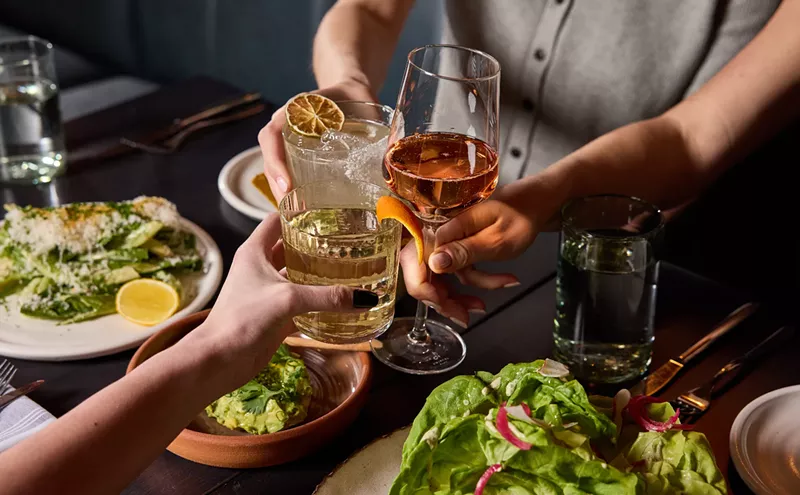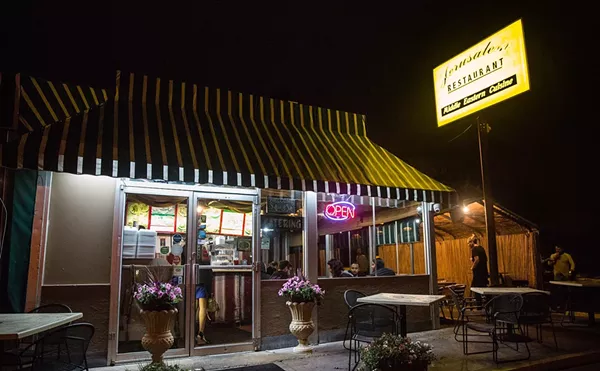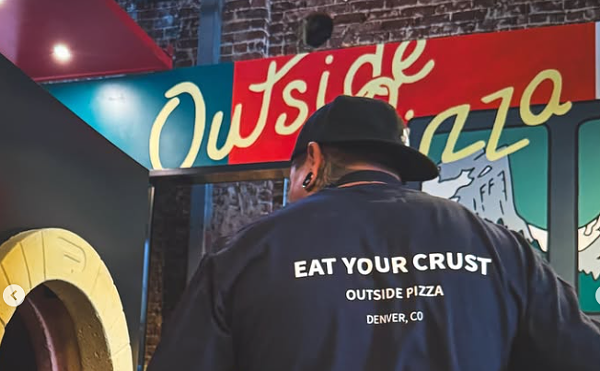Radek Cerny isn't a nationally renowned chef, but he's been kicking around Colorado long enough that his name carries some punch. He has a reputation, earned through decades in the kitchen, and his restaurants hold a prominent place in local foodie lore. Cerny started winning fans at his European Cafe in Boulder, and those fans just became more faithful when he opened Papillon Cafe almost a decade ago. With its classic menu and chic Cherry Creek address, Papillon was a darling of the food scene for years, then suddenly closed its doors a few weeks ago. The only explanation Cerny provided was that he was burned out; he now would concentrate all of his energies on Le Chantecler, the country-French restaurant he opened in Niwot almost three years ago.
As I sat down in this last surviving outpost of chef Cerny's culinary kingdom, I felt all the weight of that reputation hanging over me. I searched through Le Chantecler's menu and tried to absorb every detail about this place -- which, at least for the time being, will be the sole focus of his experience and talent. And that's probably why I didn't notice the guy at the table next to me having the ahi tuna carpaccio. He was the sort I usually peg right away as being ripe with entertaining possibilities, what with the earnest expression, the modest girth just shading over into porky, and the fervent gleam in his eyes that looked halfway between amphetamine psychosis and fanatic religious conversion. Normally, I would have picked him out as soon as I stepped into the dining room, but like I said, I was distracted. Thankfully, the Food Gods (in particular, the ones who watch over loudmouth, half-bright critics like me) are munificent with their prodigal offspring and saw fit to have me seated next to him, anyway.
And finally, I did see that this guy was having the carpaccio. He was having the same ahi tuna carpaccio that I was having, and he was thrilled with it, raving in restrained tones, but clearly on the verge of going into convulsions of bogus-foodie ecstasy.
I watched as he cut off a big piece with the edge of his fork, swirled it along the edge of the plate until it was dripping with Thai vinaigrette, then poked it across the table at his dinner companion, who smiled and politely tried to wave it off. The foodie insisted, jabbing the tuna-laden fork at his friend. Because the dining room was noisy, I couldn't hear what he was saying, but I imagine it went something like this:
"Bob," the foodie says. "Try the tuna. It's fantastic." Poke. "It's fabulous, Bob." Poke. Poke. "Bob, I'm telling you. Try this tuna." Poke.
Meanwhile, Bob was looking desperately around the dining room for a means of escape. He was searching for doors, open windows, the timely intervention of a busboy refilling water glasses, anything. Secretly, I was praying that Bob would pick up his butter knife and jab his foodie friend in the neck, but instead, at last, he tried the tuna. He took the fat, purplish chunk of ahi that had been quivering on the end of the foodie's fork dripping vinaigrette all over the tablecloth, put it in his mouth, chewed twice and swallowed.
And the face he made was priceless. Like two caterpillars humping, his eyebrows squirmed and met in the middle of his forehead, his eyes shut, his mouth twisted into a grimace like his teeth had just told a dirty joke and his lips were trying to get away, and his Adam's apple jerked up and down as he attempted to finish swallowing.
Bob, apparently, did not like the tuna. And yet, across the table, the foodie grinned a broad, stupid grin and dug right back in, rolling his eyes and totally in love with every last bite.
Me? I was with Bob. I was sitting close enough that I could see the foodie's plate, and his tuna looked the same as mine: It was sliced, plated and (obviously) prepared the same as mine, presented with the same sour capers, cornichons, rounds of baguette and cube of green wasabi. So why was he transported on waves of gustatory bliss while I sat there firmly rooted in front of a half-finished plate?
Simple: The foodie was an idiot. He either didn't realize or simply didn't care that the preparation of carpaccio is a delicate business. Cut the raw meat too thick and the texture gets in front of the flavor -- it goes mushy and soft in exactly the way it shouldn't -- but cut it too thin and it sticks to the plate. Erring on the side of generosity, Le Chantecler's kitchen was slicing too thick this night, and while the vinaigrette was excellent -- gently tart, but mellow enough that, had the fish been properly cut, it wouldn't have overpowered the ahi's luxurious flavor -- it exacerbated the icky texture because the acidity of the vinegar slicked and further softened the already suffering carpaccio.
Also in front of me were the remains of a second appetizer, this one off the specials menu, which had as a heart a single, small round of Haystack Mountain goat cheese (made right down the way at the Haystack Mountain goat farm) in a delicate crust, perfectly browned, served with spearheads of grilled bread and roasted red pepper strips. The round was so small that when the plate first came to the table, I was ready to take my server aside and ask if she'd dropped half of it on the floor on her way out from the kitchen -- but that was until I tasted it.
There are some things in this world -- like black caviar, truffles and heroin -- that should be delivered in small, controlled doses to thwart the natural gluttonous impulses of the human animal. Same with this artisan cheese. Given the opportunity, I would have wolfed down every round in the place, spreading it on bread, menus, my dinner companions, anything close at hand, and still been hungry for more the next day. It was amazing: perfectly smooth and pure white with an earthy funk and a solid, lingering aftertaste that hung at the back of my tongue like a great memory barely recalled. There was love (and the labor of a few good goats) in this cheese, and the dedication of the dairy that produced it flowed through every bite.
Trouble was, the kitchen had mounded greens so heavily on the plate that the single, tiny round of this exquisite cheese appeared lost in an arugula forest. Maybe that's just a small thing, more a matter of artifice than flavor, but it was this same imbalance, this inattention to details both little and large, that marked my entire meal this night, as well as subsequent meals. Between my own grazing and the bites I filched off the plates of friends dining with me, I made a pretty good run at the menus. (There are at least four of them, including an eclectic, globe-trotting wine list assembled by master sommelier Sally Mohr with a good spread of selections offered by the glass, bottle or half-bottle.) And on almost every plate, I found excellent ingredients treated carelessly, or missed opportunities that could easily have elevated a dish from mediocrity to a true work of art.
There was the pork "mirabelle" made with some of the most tender, perfect pork loin I've ever tasted, but served with a thin, weak honey-plum sauce lacking that heavy bass note necessary for creating fruit-and-meat harmony. The veal "asparagus" (so named, I suppose, because the veal was served with lightly grilled asparagus in addition to the less-than-inspirational steamed vegetables served on every other plate) was another disappointment, the meat bathed in a veal glaze braced up with onions and salt that was grasping toward strength and richness, but just kept falling short. It wasn't bad, but it didn't hit the mark I know the kitchen was aiming for. It simply lacked the passion that a caring hand would have given it -- had caring hands been involved in its making.
That first night I tried an entree of prosciutto-wrapped shrimp served over a Milanese (translation: chunks of tomato and flavorless mushrooms tossed in as an afterthought) risotto that was an insult to three ingredients I hold very dear. The prosciutto was dry and tough, the shrimp it embraced were plunked down thoughtlessly into a risotto that was pasty and under-cooked, and the whole thing was a mess from top to bottom. I would have been even more irritated had I not followed it rapidly with a crème brûlée that was one of the best I've had in longer than I can remember.
On another visit, I wanted to order the pâté campagnard to see how Le Chantecler would handle a classic recipe with little room for interpretation, only to be told by a waiter that the kitchen had run out of it earlier in the evening, but that I "wasn't missing anything exciting."
Instead, I went for the Louisiana crab cake, which came beautifully browned and served with a smooth, spicy remoulade swirled with vivid orange and green flavored oils -- but the cake was so thickly studded with celery and diced chunks of bell pepper that I could taste little else. Strangely, the fat little crab cake had been mounted on a lump of mashed potatoes (I assumed to lift it out of the sauce so it wouldn't get soggy), and you know things have gone terribly wrong when the mashed potatoes, supposedly present only as a form of architectural buttressing, are the most palatable thing on a plate.
Le Chantecler is serving the cuisine of distraction: food suffering pitiably from a lack of focus and attention to detail. The menus are full of noise and clamor, with dishes bouncing all over the culinary spectrum, but lacking the cohesion that can make a good restaurant's carte du jour seem less like a casual list of what the kitchen is cooking that night and more like the program for a good piece of theater -- laid out by player, act and scene, with an internal sense of building drama. But then, occasionally, I found true touches of artistry -- like the golden, whipped potatoes drowning in butter served piped into a scalloped shell that tasted like an excellent Indian pappadum -- which made me know in my bones that this kitchen could do better if it would only try.
Food knows when you no longer care. Every single thing you lay your hands on in the kitchen has a secret life of its own, and if you're tired, if you're angry, if you're bored or frenzied or burned out, and especially if you're in love, the food knows it and all of these emotions will come through in the things that you cook. True, with its comfortable dining rooms, polished silver, sparkling glassware and casual, rustic charm, Le Chantecler is a beautiful place to eat, but the tragedy is that right now, there aren't any beautiful meals being served there. I won't presume to guess at what might be going on in Le Chantecler's galley or in the lives of those working there (Dale Lamb, with whom Cerny worked at European Cafe, is the current chef de cuisine), and I won't grumble over what might really be behind Radek Cerny's recent moves. But I do know for sure that what's going on here can only be cured by a reinvestment of devotion to the little things, those trivialities and small touches that make all the difference in the world.
How do I know that? The food told me, and the food never lies.












